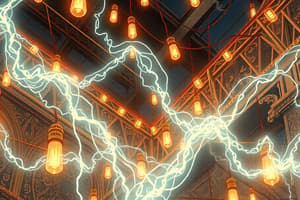Podcast
Questions and Answers
What is a characteristic of Direct Current (DC)?
What is a characteristic of Direct Current (DC)?
- Voltage remains constant over time. (correct)
- Voltage can vary in magnitude and direction.
- Current changes direction periodically.
- Commonly used for power distribution in homes.
In a purely resistive AC circuit, how does the voltage relate to the current?
In a purely resistive AC circuit, how does the voltage relate to the current?
- Voltage and current are out of phase.
- Voltage lags current by 90 degrees.
- Voltage and current are in phase. (correct)
- Voltage leads current by 90 degrees.
What is the primary function of a transformer?
What is the primary function of a transformer?
- To regulate voltage in circuits.
- To convert AC to DC.
- To store electrical energy.
- To transfer electrical energy between circuits. (correct)
What does impedance (Z) in an AC circuit refer to?
What does impedance (Z) in an AC circuit refer to?
Which statement best describes harmonics in AC?
Which statement best describes harmonics in AC?
What is the phase difference characteristic in inductive circuits?
What is the phase difference characteristic in inductive circuits?
Which equation relates the primary and secondary voltages of a transformer?
Which equation relates the primary and secondary voltages of a transformer?
What could be a consequence of increased harmonic distortion in AC systems?
What could be a consequence of increased harmonic distortion in AC systems?
Flashcards are hidden until you start studying
Study Notes
Alternating Current (AC)
AC vs DC
-
Alternating Current (AC):
- Current changes direction periodically.
- Voltage can also vary in magnitude and direction.
- Commonly used for power distribution (e.g., homes, industries).
- Examples: Household electrical outlets.
-
Direct Current (DC):
- Current flows in a single direction.
- Voltage remains constant over time.
- Commonly used in batteries and electronic devices.
- Examples: Flashlights, mobile phones.
Phase Difference
- Definition: The difference in phase angle between two alternating currents or voltages.
- Measured in degrees (°) or radians (rad).
- Key Points:
- In a purely resistive circuit, voltage and current are in phase (0° difference).
- In inductive circuits, current lags voltage (phase difference > 0°).
- In capacitive circuits, current leads voltage (phase difference < 0°).
Transformers
- Function: Devices that transfer electrical energy between two or more circuits through electromagnetic induction.
- Types:
- Step-up transformers: Increase voltage while decreasing current.
- Step-down transformers: Decrease voltage while increasing current.
- Key Concepts:
- Transformer efficiency depends on design and load.
- Ideal transformers: Input power equals output power (ignoring losses).
- Transformer equation: Vp/Vs = Np/Ns (Voltage ratio = Turns ratio).
AC Circuit Analysis
- Components: Resistors, inductors, capacitors.
- Impedance (Z): Total opposition to AC current, combines resistance (R) and reactance (X).
- Key Calculations:
- Ohm's Law: V = I * Z (where V = voltage, I = current).
- Reactance:
- Inductive reactance (XL) = 2πfL
- Capacitive reactance (XC) = 1/(2πfC)
- Phasors: Used to represent AC voltages and currents in complex form, simplifying calculations.
Harmonics in AC
- Definition: Voltage or current waveforms that deviate from the fundamental frequency (e.g., 60 Hz or 50 Hz).
- Causes: Non-linear loads (e.g., rectifiers, fluorescent lights).
- Key Points:
- Harmonics can create distortion in power systems.
- Common harmonics: 3rd, 5th, 7th, etc.
- Harmonic distortion is measured using Total Harmonic Distortion (THD).
- Mitigation methods include filters and harmonic compensators.
AC vs DC
- Alternating Current (AC):
- Direction of current periodically reverses.
- Voltage fluctuates in both magnitude and direction.
- Predominantly utilized in power distribution systems, particularly in residential and industrial settings.
- Typical application includes standard household electrical outlets.
- Direct Current (DC):
- Current flows in one uninterrupted direction.
- Voltage remains stable over time.
- Commonly found in batteries and various electronic devices.
- Examples include flashlights and mobile phones.
Phase Difference
- Understanding Phase Difference: Indicates the phase angle variation between two AC currents or voltages.
- Measured in degrees (°) or radians (rad).
- Behavior in Circuits:
- In purely resistive circuits, voltage and current are aligned (0° phase difference).
- In inductive circuits, the current lags behind the voltage (positive phase difference).
- In capacitive circuits, the current leads the voltage (negative phase difference).
Transformers
- Purpose: Facilitate the transfer of electrical energy between multiple circuits through the principle of electromagnetic induction.
- Transformer Types:
- Step-up transformers increase voltage while decreasing current.
- Step-down transformers reduce voltage while boosting current.
- Efficiency: Depends on design and load; in ideal conditions, input and output power are equal, excluding losses.
- Key Formula: Voltage ratio (Vp/Vs) corresponds to the turns ratio (Np/Ns) in the transformer equation.
AC Circuit Analysis
- Fundamental Components: Resistors, inductors, and capacitors make up an AC circuit.
- Impedance (Z): Represents total opposition to AC current; combines resistance (R) and reactance (X).
- Notable Calculations:
- Ohm's Law is modified for AC; V = I * Z (where V is voltage, I is current).
- Reactance definitions:
- Inductive reactance (XL) defined as XL = 2πfL.
- Capacitive reactance (XC) calculated as XC = 1/(2πfC).
- Phasors: Employed for representing AC voltages and currents in complex form, thereby streamlining mathematical operations.
Harmonics in AC
- Definition: These are voltage or current waveforms that deviate from the primary frequency (typically 60 Hz or 50 Hz).
- Origin: Commonly arise from non-linear electrical loads such as rectifiers and fluorescent lighting.
- Impact: Harmonics can introduce distortion into power systems.
- Frequent Harmonics: Notable harmonics include the 3rd, 5th, 7th, and higher orders.
- Distortion Measurement: Total Harmonic Distortion (THD) quantifies the extent of harmonic distortion.
- Mitigation Strategies: Implementation of filters and harmonic compensators can reduce the effects of harmonics.
Studying That Suits You
Use AI to generate personalized quizzes and flashcards to suit your learning preferences.




